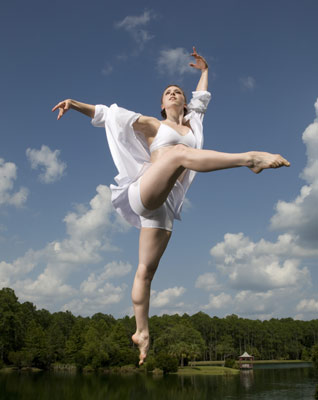
He avoids seeing the work of other choreographers, posts podcasts of his work on iTunes, and recently passed up New York City in favor of Boise, Idaho. Trey McIntyre, it seems, is justified in calling himself an innovator.
At 39 years old, McIntyre already has 20 years of experience as a freelance choreographer, having started out as a choreographic apprentice at Houston Ballet and gone on to create original works for ballet companies worldwide. In 2004, McIntyre founded Trey McIntyre Project (TMP), working each summer with some of the most talented dancers in America. Last year, TMP transitioned into a full-time touring company, and for the first time, McIntyre is creating new contemporary ballets on a company of dancers who won’t disappear with the new season.

On Wednesday, February 18, TMP makes its Santa Barbara debut. I spoke to McIntyre on the phone from Boise last week.
What made you choose Boise?
We were searching for where our home base would be, and a friend who runs this amazing children’s dance program in Boise thought people here would be responsive to the work. The company immediately fell in love with city; it’s a wonderful place to live. We could easily have moved to New York or San Francisco. It may have been easier because of funding. But there’s such a divide in the US in terms of support for the arts. If we’re not bringing the best possible work to people all over the US, then we are really failing them. Why would they develop a taste for the arts if they’re not seeing it as part of their lifestyle? Choosing Boise felt like a pioneering part of our mission.
We tour 27 weeks of the year, so we’re not isolated in the Midwest, but as a home base, it makes a lot of sense. Helping to create a city’s cultural theme from the ground up is pretty exciting. It’s a not a common opportunity, so in terms of being an innovator, why go to a place where it already exists?
Tell me about the difference between working with dancers once a year, and working with them full-time.
There’s a certain level of trust that is necessary for an artist to go to places that aren’t so comfortable. It takes digging around to get to a place that’s more vulnerable and deeper and more significant. It takes an environment that feels safe. It takes knowing each other better and feeling the freedom to experiment. For the first time, I have the continuity to move forward that way.
Are your dancers artistic collaborators, and in what ways?

They are huge collaborators, though not so much in creating movement, because I don’t see any reason for that. I am not looking for material-it’s more about how they exist within the work. In rehearsal, I tend to work on a short phrase and then watch them and look at the opportunities. How do they approach the half-seconds? I really pay attention to who they are that day, where their energy is, how I can challenge them personally. I spend a lot of time getting to know them, their curiosity, their bravery. How willing are they going to be to go beyond what they already know they do well?
Another great benefit of being with the dancers all the time on the road is that we get to find ways for them to be continually spontaneous, and true to themselves. It takes a lot of care; it’s like parenting in a way, in its best incarnation-guiding them through the process of their own growth. I think it makes for a more exciting performance-what you’re seeing is not acting, but true presence.
What is it that keeps you based in ballet technique rather than in modern?
Early on in my career, I felt so confined in classical ballet. I wanted to smash it apart. Ben Stevenson, my mentor at Houston Ballet, kept reacquainting me with the technique and the language that I learned growing up in classical ballet. There came a point where it dawned on me that ballet not a limitation; it’s a way of speaking clearly. I can create movement that pushes in any direction I want to, but as long as the dancer has that basis and we speak through this common language, it’s communicated more clearly in the end. In that way, it’s actually more liberating.

The important part of the work I do is getting to honesty at all costs-what needs to be said instead of what my ego wants me to say. It’s easy to hide that behind a wall of something aesthetically pleasing or exciting, and ballet helps keep me on the path of truth, helps me say things without mumbling. But it’s also important for me to keep moving the form forward, to keep finding out what’s true to this moment in time.
Can you cite any choreographic influences?
I tend to be influenced by other art forms more than dance. Right now I’m really into Charlie Kaufman, the screenwriter. I’m also inspired by Dave Chappell, his style of performing, just the life choices he makes as a human being. I see the influence of that more in the studio. I actually make a concerted effort to avoid seeing other choreographers’ work.
Tell me about one of the pieces on the program.
Leatherwing Bat is set to a Peter, Paul and Mary kids album. Peter Yarrow actually saw the premiere at Jacob’s Pillow. I’m fairly certain my mom listened to the album when I was in the womb. It struck me that listening to that music, my insides felt like they did when I was three. My response was the same. That seemed like a good, crunchy place to start thinking about the ballet: What are the parts of yourself as an adult that remain unchanged?
What else should Santa Barbara know about your work?
We have a podcast series online. It’s available in its best form on iTunes. I think it’s a really great way to introduce people to the company, to let them get to know the dancers. I think also there is a certain audience for podcasts that might not make it to our performances, so I’m excited that it can expand the reach and scope of what we do.
4•1•1
Trey McIntyre Project performs on Wednesday, February 18th at 8pm at UCSB’s Campbell Hall. For more information, call 893-3535 or visit artsandlectures.ucsb.edu.



